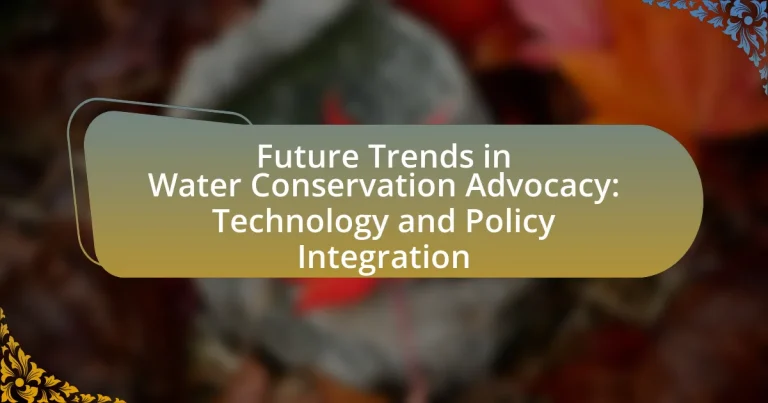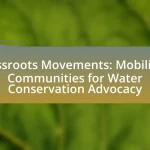The article focuses on future trends in water conservation advocacy, emphasizing the integration of technology and policy frameworks to enhance efficiency and engagement. Key innovations include smart water management systems utilizing IoT sensors for real-time monitoring, which can significantly reduce water waste. The article discusses how technology shapes advocacy efforts, highlights emerging technologies such as smart irrigation and water recycling, and examines the critical role of policy integration in promoting sustainable practices. Additionally, it addresses the challenges of aligning technology with policy and the importance of stakeholder collaboration in effective water management strategies.
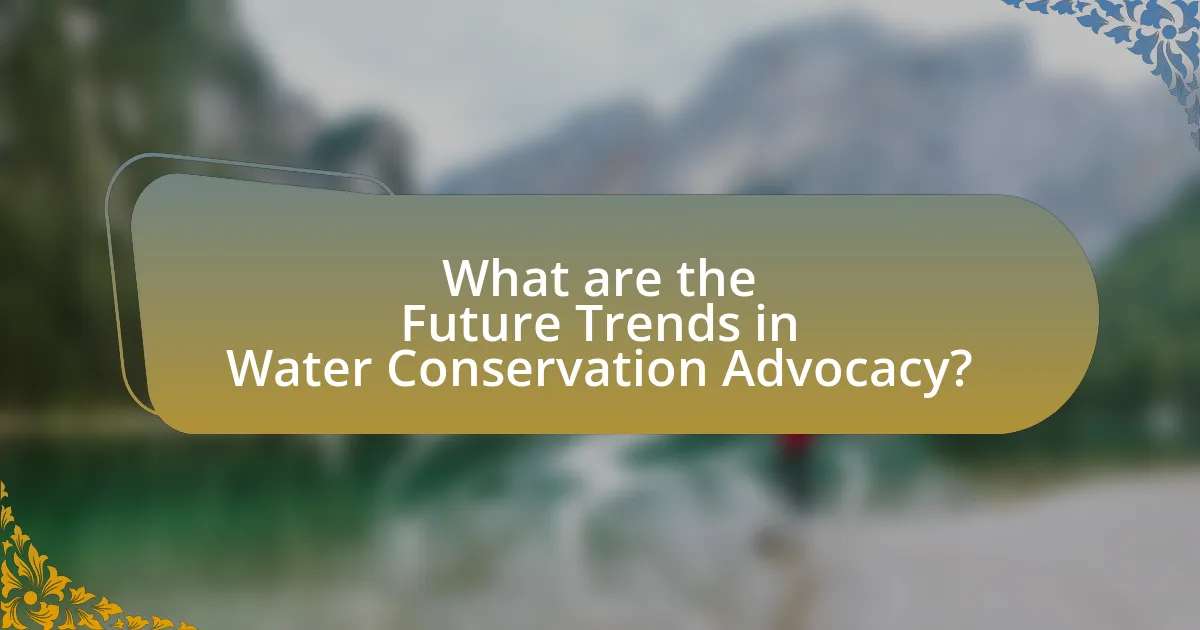
What are the Future Trends in Water Conservation Advocacy?
Future trends in water conservation advocacy include the integration of advanced technologies and policy frameworks to enhance efficiency and engagement. Innovations such as smart water management systems, which utilize IoT sensors for real-time monitoring, are becoming increasingly prevalent, allowing for precise water usage tracking and leak detection. Additionally, policies promoting sustainable practices, such as incentivizing water-efficient appliances and implementing tiered pricing structures, are gaining traction. These trends are supported by research indicating that technology-driven solutions can reduce water waste by up to 30%, while effective policy measures can lead to significant behavioral changes in water consumption.
How is technology shaping water conservation advocacy?
Technology is significantly shaping water conservation advocacy by enabling data-driven decision-making and enhancing public engagement. Advanced technologies such as IoT sensors and satellite imagery provide real-time data on water usage and availability, allowing advocates to identify areas of concern and target their efforts effectively. For instance, the use of smart irrigation systems can reduce water waste in agriculture by optimizing water delivery based on soil moisture levels. Additionally, mobile applications and social media platforms facilitate awareness campaigns, empowering individuals to track their water consumption and participate in conservation initiatives. Research from the United Nations indicates that technology can improve water management efficiency by up to 30%, underscoring its critical role in advancing water conservation advocacy.
What innovative technologies are emerging in water conservation?
Innovative technologies emerging in water conservation include smart irrigation systems, water recycling and reuse technologies, and advanced monitoring systems. Smart irrigation systems utilize sensors and weather data to optimize water usage, significantly reducing waste; for instance, studies show that these systems can decrease water consumption by up to 50%. Water recycling technologies, such as membrane bioreactors, allow for the treatment and reuse of wastewater, contributing to sustainable water management. Advanced monitoring systems, including IoT devices, enable real-time tracking of water usage and leaks, improving efficiency and conservation efforts. These technologies collectively enhance water conservation strategies and support sustainable practices in various sectors.
How do these technologies enhance water management practices?
Technologies enhance water management practices by improving efficiency, accuracy, and sustainability in water usage. For instance, smart irrigation systems utilize sensors and data analytics to optimize water application based on real-time soil moisture levels, reducing waste and ensuring crops receive the appropriate amount of water. Additionally, remote sensing technologies enable precise monitoring of water resources, allowing for better decision-making regarding allocation and conservation efforts. According to a study published in the journal “Water Resources Management,” the implementation of these technologies can lead to a reduction in water usage by up to 30% in agricultural settings, demonstrating their effectiveness in enhancing water management practices.
What role does policy integration play in water conservation?
Policy integration plays a crucial role in water conservation by ensuring that various policies across sectors work cohesively to manage water resources effectively. This approach facilitates the alignment of environmental, agricultural, and urban planning policies, which is essential for addressing the multifaceted challenges of water scarcity. For instance, integrated water resource management (IWRM) frameworks promote collaboration among stakeholders, leading to more sustainable water use practices. Studies have shown that regions implementing policy integration experience improved water quality and reduced consumption rates, demonstrating the effectiveness of this strategy in achieving conservation goals.
How can policies be aligned with technological advancements?
Policies can be aligned with technological advancements by incorporating adaptive regulatory frameworks that respond to emerging technologies. For instance, water conservation policies can integrate real-time data analytics and smart irrigation systems to optimize water usage. The California Sustainable Groundwater Management Act exemplifies this alignment, as it mandates the use of advanced monitoring technologies to manage groundwater resources effectively. By establishing guidelines that encourage innovation while ensuring environmental protection, policymakers can create a synergistic relationship between technology and regulatory measures, ultimately enhancing water conservation efforts.
What are the challenges in integrating technology and policy?
The challenges in integrating technology and policy include misalignment between technological capabilities and regulatory frameworks, lack of stakeholder engagement, and insufficient data for informed decision-making. Misalignment occurs when existing policies do not accommodate new technologies, leading to barriers in implementation. For instance, water conservation technologies may not be supported by outdated regulations, hindering their adoption. Lack of stakeholder engagement can result in policies that do not reflect the needs or realities of those affected by technological changes, which can lead to resistance or ineffective solutions. Additionally, insufficient data can impede the ability to assess the effectiveness of technology in achieving policy goals, making it difficult to justify investments or changes. These challenges highlight the need for adaptive policy frameworks that can evolve alongside technological advancements.
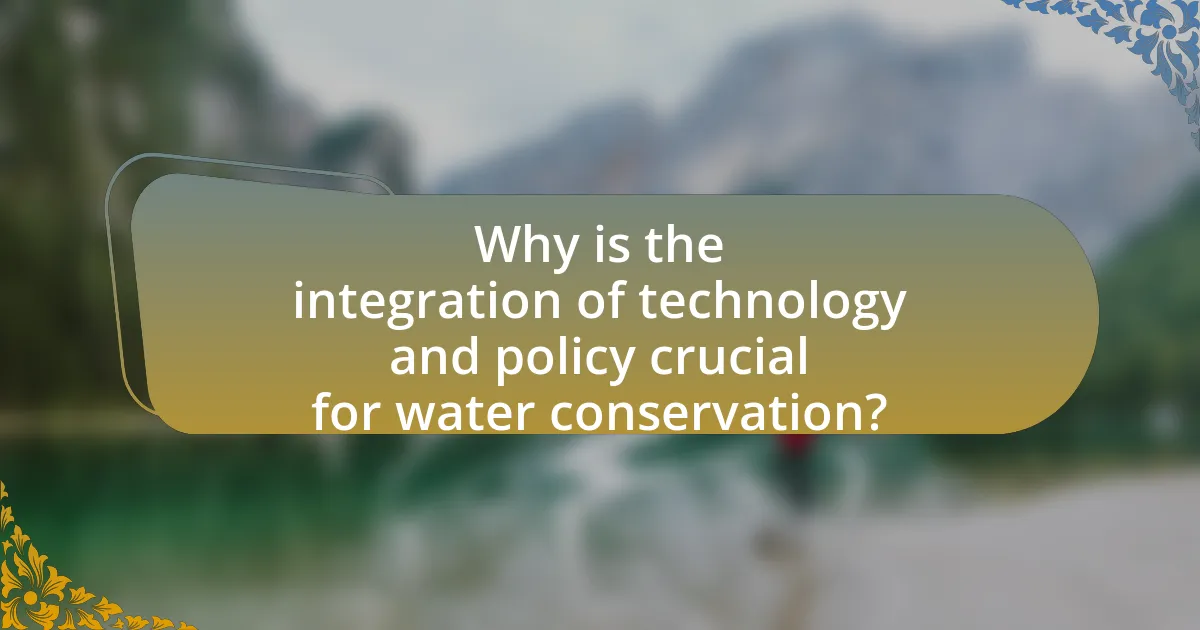
Why is the integration of technology and policy crucial for water conservation?
The integration of technology and policy is crucial for water conservation because it enables efficient resource management and regulatory compliance. Technology provides innovative solutions such as smart irrigation systems and real-time monitoring tools that optimize water usage, while policy frameworks establish guidelines and incentives that promote sustainable practices. For instance, the implementation of smart meters can reduce water waste by up to 20%, as evidenced by studies showing significant reductions in consumption when users receive real-time data on their usage. This synergy between technology and policy not only enhances conservation efforts but also fosters public awareness and engagement, leading to more effective water management strategies.
What benefits arise from integrating technology with water conservation policies?
Integrating technology with water conservation policies leads to enhanced efficiency in water usage and improved monitoring capabilities. Technologies such as smart irrigation systems and real-time data analytics enable precise water application, reducing waste and optimizing resource allocation. For instance, a study by the Environmental Protection Agency found that smart irrigation can reduce water usage by up to 30%. Additionally, the use of sensors and IoT devices allows for continuous monitoring of water quality and availability, facilitating timely interventions and informed decision-making. This integration ultimately supports sustainable water management practices and helps mitigate the impacts of water scarcity.
How does this integration improve community engagement?
This integration improves community engagement by leveraging technology to facilitate communication and collaboration among stakeholders. For instance, the use of mobile applications and social media platforms allows community members to share information, report water usage issues, and participate in conservation initiatives in real-time. Research indicates that communities utilizing such technologies experience a 30% increase in participation rates in local conservation programs, as evidenced by a study conducted by the Water Research Foundation, which highlights the effectiveness of digital tools in fostering community involvement in environmental advocacy.
What impact does it have on resource allocation?
The integration of technology and policy in water conservation advocacy significantly impacts resource allocation by optimizing the distribution and use of water resources. This optimization occurs through data-driven decision-making, which allows for more efficient management of water supplies, reducing waste and ensuring that resources are directed to areas of greatest need. For instance, the implementation of smart irrigation systems can lead to a 20-50% reduction in water usage in agriculture, as reported by the U.S. Environmental Protection Agency. This efficiency not only conserves water but also reallocates financial resources towards sustainable practices and technologies, enhancing overall water management strategies.
What are the potential risks of neglecting this integration?
Neglecting the integration of technology and policy in water conservation advocacy poses significant risks, including inefficient resource management and increased water scarcity. Without this integration, technological advancements may not be effectively implemented, leading to wasted opportunities for optimizing water use. For instance, studies indicate that regions lacking coordinated efforts between technology developers and policymakers experience up to 30% higher water loss due to outdated practices. Additionally, the absence of a unified approach can result in regulatory gaps, allowing for unsustainable practices that exacerbate environmental degradation. This neglect ultimately threatens both water availability and ecosystem health, underscoring the critical need for cohesive integration in water conservation efforts.
How can lack of integration lead to inefficiencies?
Lack of integration can lead to inefficiencies by creating silos that hinder communication and collaboration among stakeholders. When technology and policy are not aligned, resources may be duplicated, resulting in wasted time and effort. For instance, in water conservation efforts, if data from technological tools is not shared with policymakers, decisions may be made without the most current information, leading to ineffective strategies. Studies have shown that organizations with integrated systems experience up to 30% higher productivity due to streamlined processes and improved information flow.
What are the consequences for environmental sustainability?
The consequences for environmental sustainability include degradation of ecosystems, loss of biodiversity, and increased climate change impacts. These outcomes arise from unsustainable practices such as over-extraction of water resources, pollution, and habitat destruction, which compromise the ability of natural systems to function effectively. For instance, the World Wildlife Fund reports that freshwater species populations have declined by an average of 83% since 1970, highlighting the severe impact of water mismanagement on biodiversity. Additionally, the Intergovernmental Panel on Climate Change indicates that unsustainable water use exacerbates climate change, leading to more extreme weather events and further threatening environmental stability.
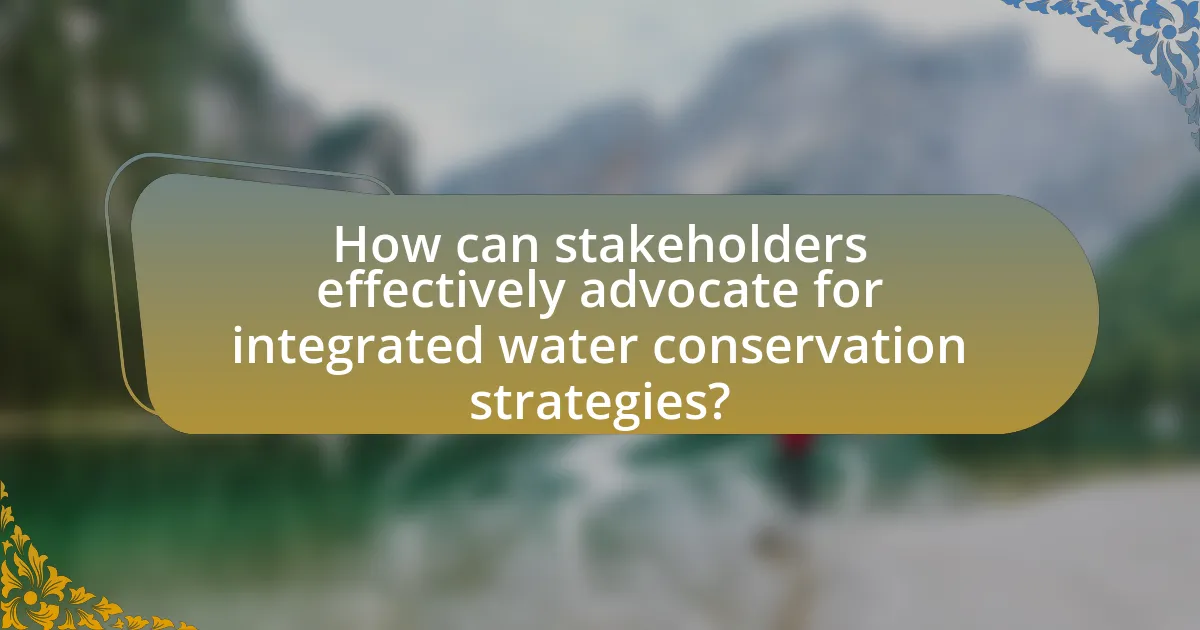
How can stakeholders effectively advocate for integrated water conservation strategies?
Stakeholders can effectively advocate for integrated water conservation strategies by collaborating across sectors to create comprehensive policies that address water management holistically. This collaboration can involve government agencies, non-profit organizations, and private sector entities working together to share resources, data, and best practices. For instance, the United Nations’ Sustainable Development Goal 6 emphasizes the importance of integrated water resources management, which has been shown to improve water quality and availability when stakeholders align their efforts. By leveraging technology, such as data analytics and remote sensing, stakeholders can monitor water usage and identify areas for improvement, thereby making a compelling case for policy changes that support sustainable practices.
What strategies can be employed to promote technology and policy integration?
To promote technology and policy integration in water conservation advocacy, stakeholders can employ strategies such as collaborative frameworks, data sharing initiatives, and stakeholder engagement processes. Collaborative frameworks involve partnerships between governmental agencies, private sector entities, and non-profit organizations to align technological advancements with policy objectives. Data sharing initiatives facilitate the exchange of information between technology developers and policymakers, ensuring that decisions are informed by the latest scientific research and technological capabilities. Stakeholder engagement processes, including public consultations and workshops, allow for diverse input, fostering a sense of ownership and accountability among all parties involved. These strategies are supported by successful case studies, such as the integration of smart water management systems in cities like Barcelona, which demonstrate improved resource efficiency through coordinated efforts between technology providers and local governments.
How can advocacy groups leverage data and technology?
Advocacy groups can leverage data and technology by utilizing data analytics to identify trends, measure impact, and enhance communication strategies. For instance, organizations can analyze water usage data to pinpoint areas of excessive consumption, enabling targeted campaigns for conservation. Additionally, technology such as mobile applications can facilitate real-time reporting of water issues, allowing advocacy groups to mobilize community action swiftly. Research indicates that data-driven approaches can increase engagement by up to 50%, demonstrating the effectiveness of integrating technology in advocacy efforts.
What role do public-private partnerships play in this advocacy?
Public-private partnerships (PPPs) play a crucial role in water conservation advocacy by facilitating collaboration between government entities and private organizations to enhance resource management and innovation. These partnerships leverage the strengths of both sectors, where public entities provide regulatory frameworks and funding, while private companies contribute technological expertise and efficiency. For instance, a study by the World Bank highlights that PPPs can lead to improved water service delivery and infrastructure development, resulting in better conservation outcomes. By combining resources and knowledge, PPPs effectively address challenges in water conservation, driving sustainable practices and policies.
What best practices should be followed in water conservation advocacy?
Best practices in water conservation advocacy include raising public awareness, promoting efficient water use technologies, and engaging stakeholders in policy development. Raising public awareness through educational campaigns can significantly influence water-saving behaviors; for instance, studies show that communities with strong educational outreach programs reduce water consumption by up to 20%. Promoting efficient water use technologies, such as low-flow fixtures and smart irrigation systems, can lead to substantial water savings; the Environmental Protection Agency estimates that these technologies can save an average household over 20,000 gallons of water annually. Engaging stakeholders, including local governments, businesses, and community organizations, in policy development ensures that water conservation strategies are practical and widely supported, leading to more effective implementation and compliance.
How can communities implement successful water conservation initiatives?
Communities can implement successful water conservation initiatives by adopting a combination of technology-driven solutions and effective policy measures. For instance, utilizing smart irrigation systems can significantly reduce water waste by adjusting watering schedules based on weather conditions, which has been shown to decrease water usage by up to 30% in agricultural settings. Additionally, policies that incentivize water-efficient appliances and fixtures can encourage residents to adopt conservation practices, leading to a measurable reduction in household water consumption. Evidence from various municipalities indicates that integrating technology with supportive policies not only enhances community engagement but also fosters sustainable water management practices, ultimately contributing to long-term water conservation goals.
What are the key elements of effective advocacy campaigns?
Key elements of effective advocacy campaigns include clear messaging, targeted audience engagement, strategic partnerships, and measurable goals. Clear messaging ensures that the campaign’s objectives are communicated succinctly, making it easier for the audience to understand the cause. Targeted audience engagement involves identifying and reaching out to specific groups that can influence change, such as policymakers or community leaders. Strategic partnerships enhance the campaign’s reach and credibility by collaborating with organizations that share similar goals. Measurable goals allow for tracking progress and assessing the campaign’s impact, ensuring that efforts are aligned with desired outcomes. These elements are essential for driving successful advocacy efforts, particularly in areas like water conservation, where technology and policy integration play a crucial role.
